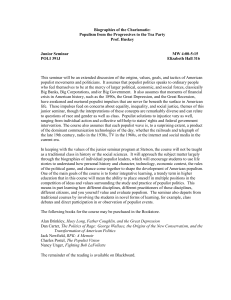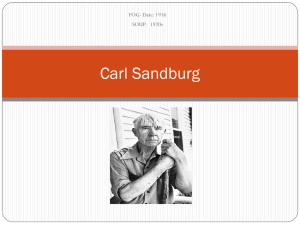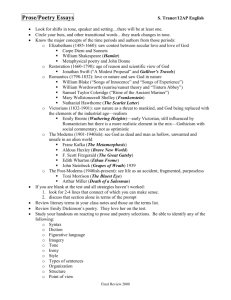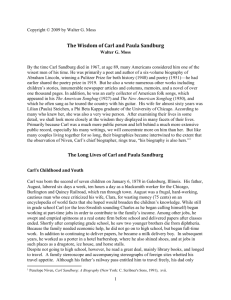M Regan_final - Journal of Aesthetics & Protest
advertisement
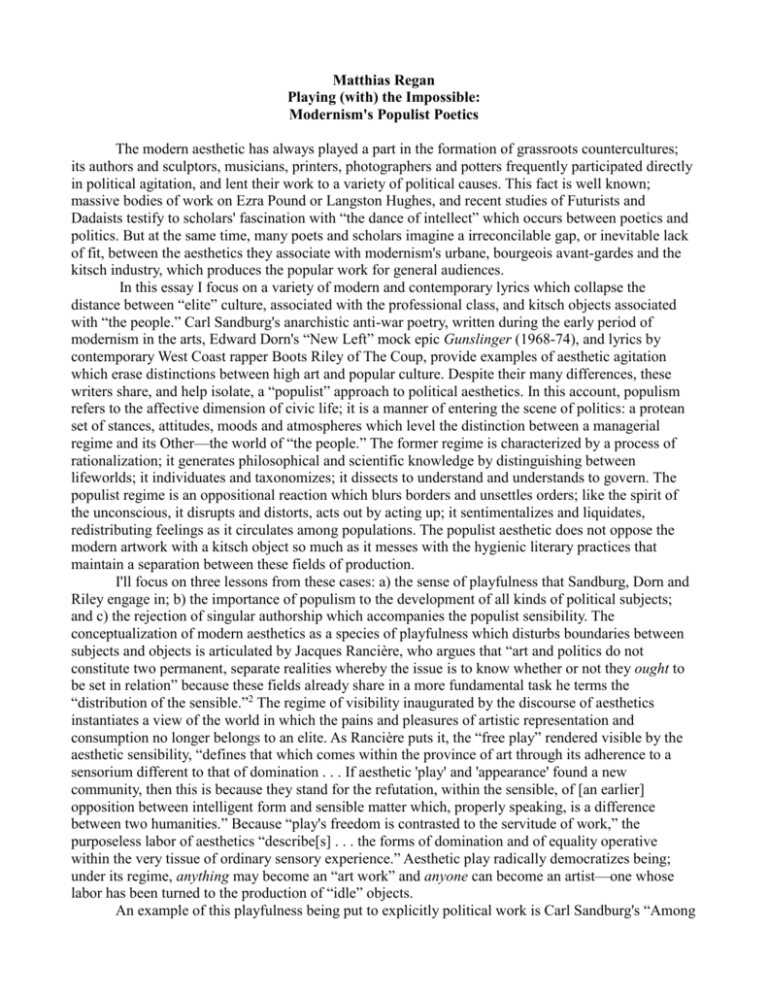
Matthias Regan Playing (with) the Impossible: Modernism's Populist Poetics The modern aesthetic has always played a part in the formation of grassroots countercultures; its authors and sculptors, musicians, printers, photographers and potters frequently participated directly in political agitation, and lent their work to a variety of political causes. This fact is well known; massive bodies of work on Ezra Pound or Langston Hughes, and recent studies of Futurists and Dadaists testify to scholars' fascination with “the dance of intellect” which occurs between poetics and politics. But at the same time, many poets and scholars imagine a irreconcilable gap, or inevitable lack of fit, between the aesthetics they associate with modernism's urbane, bourgeois avant-gardes and the kitsch industry, which produces the popular work for general audiences. In this essay I focus on a variety of modern and contemporary lyrics which collapse the distance between “elite” culture, associated with the professional class, and kitsch objects associated with “the people.” Carl Sandburg's anarchistic anti-war poetry, written during the early period of modernism in the arts, Edward Dorn's “New Left” mock epic Gunslinger (1968-74), and lyrics by contemporary West Coast rapper Boots Riley of The Coup, provide examples of aesthetic agitation which erase distinctions between high art and popular culture. Despite their many differences, these writers share, and help isolate, a “populist” approach to political aesthetics. In this account, populism refers to the affective dimension of civic life; it is a manner of entering the scene of politics: a protean set of stances, attitudes, moods and atmospheres which level the distinction between a managerial regime and its Other—the world of “the people.” The former regime is characterized by a process of rationalization; it generates philosophical and scientific knowledge by distinguishing between lifeworlds; it individuates and taxonomizes; it dissects to understand and understands to govern. The populist regime is an oppositional reaction which blurs borders and unsettles orders; like the spirit of the unconscious, it disrupts and distorts, acts out by acting up; it sentimentalizes and liquidates, redistributing feelings as it circulates among populations. The populist aesthetic does not oppose the modern artwork with a kitsch object so much as it messes with the hygienic literary practices that maintain a separation between these fields of production. I'll focus on three lessons from these cases: a) the sense of playfulness that Sandburg, Dorn and Riley engage in; b) the importance of populism to the development of all kinds of political subjects; and c) the rejection of singular authorship which accompanies the populist sensibility. The conceptualization of modern aesthetics as a species of playfulness which disturbs boundaries between subjects and objects is articulated by Jacques Rancière, who argues that “art and politics do not constitute two permanent, separate realities whereby the issue is to know whether or not they ought to be set in relation” because these fields already share in a more fundamental task he terms the “distribution of the sensible.”2 The regime of visibility inaugurated by the discourse of aesthetics instantiates a view of the world in which the pains and pleasures of artistic representation and consumption no longer belongs to an elite. As Rancière puts it, the “free play” rendered visible by the aesthetic sensibility, “defines that which comes within the province of art through its adherence to a sensorium different to that of domination . . . If aesthetic 'play' and 'appearance' found a new community, then this is because they stand for the refutation, within the sensible, of [an earlier] opposition between intelligent form and sensible matter which, properly speaking, is a difference between two humanities.” Because “play's freedom is contrasted to the servitude of work,” the purposeless labor of aesthetics “describe[s] . . . the forms of domination and of equality operative within the very tissue of ordinary sensory experience.” Aesthetic play radically democratizes being; under its regime, anything may become an “art work” and anyone can become an artist—one whose labor has been turned to the production of “idle” objects. An example of this playfulness being put to explicitly political work is Carl Sandburg's “Among the Red Guns,” which in the November 1914 issue of Harriet Monroe's Poetry: A Magazine of Verse. The poem begins: Among the red guns, In the hearts of soldiers Running free blood In the long, long campaign: Dreams go on. Among the leather saddles In the heads of soldiers Heavy in the wracks and kills Of all straight fighting: Dreams go on.3 These unrhymed, free verse two- and three-beat lines were among the first in English to exemplify what would become known as poetic modernism. They are composed in what William Carlos Williams would call “the American idiom,” avoid the “ornament” and “slither” Pound warns against in his “Imagist” manifesto, and condense language to the point of producing collage-like juxtapositions (“Running free blood,” “Heavy in the wracks and kills”) later associated with Symbolist and Surrealist literature. The modern style of these lines, written upon the verge of the U.S. entrance into the European war can not be differentiated from the agitation in which they engage. Style and substance share an attitude about the relation between the bodies and imaginations of working men. The line “Dreams go on” expresses the view that soldiers, despite the carnage in which they live and die, are neither heartless nor thoughtless. The contrast between the blunt language and brutal images of each stanza and the softer, more ethereal lilt of the refrain formally enacts the same distinction. We can grasp the subjectivization at play in this juxtaposition by considering political theorist Benjamin Arditi's observations about the relation between the possible and the impossible in grassroots movements. In Politics on the Edges of Liberalism: Difference, Populism, Revolution, Agitation, Arditi expands on Rancière's theories to redefine key concepts relating to grassroots politics. Contra the view of politics as the “art of the possible,” he shows how the cultural “police”—professional taste-makers who operate simultaneously in the political and cultural spheres of public life—establish a view of the world in which “the frontiers between the possible and the impossible are stable,” thus causing us to forget that “the doable is indebted to the impossible.”4 “[P]articularly in the case of emancipatory politics,” Arditi argues, “every action . . . that actually seeks to transform the conditions of the given— sets itself goals that might seem impossible. Those who partake in such actions are moved by a promise of something other to come” (Arditi, 96). Raising the impossible within the realm of the possible “shows the presence of two worlds lodged in one”. Making visible this doubleness is a form of “'agitation' in the etymological sense of setting things in motion” (ibid.). Any given crossing between the world as it is and the world as it could be may not be “enough to transform the partition of the sensible, as great transformations occur not through individual actions but by setting in motion human collectives,” but even small gestures have the value of “exemplarity”—they “stir the status quo” by initiating a disturbance which calls into question not only the possible and the impossible but also the “relation between singular and collective action” (ibid.). Each of Sandburg's dreaming soldiers is a potential war resister because each is a potential poet: a person with the imaginative capacity “to see through the veil” of official policies, which divide populations in the starkest possible manner during episodes of war.5 Another distinction policed by professional cultural makers is that between authors; the managerial worldview bind objects to their makers, a practice which individualizes cultural objects by associating them with the “personal convictions” of egos at the expense of more widespread and transitory affective states which ebb and flow through larger social bodies. Sandburg's notion of authorship emerges out of the grassroots counterculture in which he participated, as a “soap-boxer” for the Socialist party, secretary to Emil Seidal (the Socialist Mayor of Milwaukee from 1910 to 1912), member of Eugene Deb's “red special” (a campaign train used in the 1912 election) and author of hundreds of articles for leftist magazines. The presentation of his lyrics not only refuses notions of the poet as a “solitary genius” but also blurs disciplinary boundaries between genres of authorship. Consider the opening and closing lines of “Wars,” another anti-war poem: In the old wars drum of hoofs and the beat of shod feet. In the new wars hum of motors and the tread of rubber tires. In the wars to come silent wheels and whirr of rods not yet dreamed out in the heads of men. [. . . . . . . . . . . . . . . . . . . . . . . . . . . . . . . . . . . . . . . . . . . . . . . . . . . .] In the old wars kings quarreling and thousands of men following. In the new wars kings quarreling and millions of men following. In the wars to come kings kicked under the dust and millions of men following great causes not yet dreamed out in the heads of men.6 Again we see a staging of the contradiction between reality and dreams. In the first stanzas, human ingenuity is predicted to produce ever more efficient means of destruction. Then in the last line this depressing future is subverted by an alternative: a war against the kings, rather than on their behalf. “[G]reat causes not yet dreamed out in the heads of men” holds open the door to an “impossible” future, which is further complicated by the poem's original context, the July 1916 issue of the International Socialist Review. This fascinating and undervalued journal, published and edited in Chicago by Charles H. Kerr between 1900 and February 1918 (when it presses were destroyed and editors arrested by the city's police under the sedition act), was sold in lumber camps and on factory floors, and featured news articles, speeches (by Eugene Debs), stories (by Jack London) and reprints of Marx and Engels' writings. During the last several years of its existence, Sandburg published dozens of pieces in it under a variety of names. “Wars” appears directly under a three-quarter page illustration of a headless hulk standing before an Army medical examiner who proclaims, “At Last a Perfect Soldier!” The headless solider, cannon fodder unhindered by dreams, sharply contrasts with the soldiers who possess the “heads of men” in Sandburg's poems, and also with an article written by Sandburg under the pen-name Jack Phillips, which begins on the facing page of the journal with these observations: The Chicago folks who packed the Auditorium last winter to hear Irvin S. Cobb lecture on the war will never forget his terrific indictment of war and the promoters of war. He talked straight from the heart and the head and without resorting to any cheap oratorical tricks of our famous silver tongues. He walked straight into the hearts of the big audience that greeted him. All the glamor, glory and cheap tinsel with which the campaign orator will enshrine the average soldier was shown up as counterfeit when Cobb described the men who are doing the fighting in the trenches of Europe today, as looking like a bunch of sewer diggers after a hard day's work in mud and water. His lectures were the biggest thought-bombs of the season . . .7 Sandburg's prose is poetic: full of repetitions and written in the “straight” style that defined his poetry and that he extolls in Cobb's lecture. The lecture performs the stylistic gestures of the modern poem: it democratizes culture by establishing a rougher, more transparent, working-class idiom in opposition to the “cheap tinsel” of official nationalism. By describing the soldiers as “a bunch of sewer diggers,” Cobb's “thought-bombs” shower the glorious spectacle of state-instigated “preparedness” parades with the mud of modernism. Sandburg's prosaic poetry enacts a similar agitation by reducing poetry to the role of an extended caption. Generating this productive confusion was a fundamental editorial policy of the ISR, which exhibits a “kitsch” sensibility: although its position is undeniably leftist, its editorial policies imagine a culturally heterogeneous audience. The magazine was neither “high brow” nor “low brow,” nor was it “socialist” as opposed to “anarchist” or “progressive”: it was a magazine for the whole family (and even included advertisements for a socialist board game, produced by Kerr, that promises to educate as it entertains). Its intended audience was, quite simply, “the people.” Arditi explains why this productive confusion should be regarded as aesthetic populism. Populism has long been misunderstood, particularly by the left, whose members tend to see it as rightwing, rural phenomenon. In Slavoj Žižek's words, populism is a “temptation” to be avoided. This view misconceives the essence of populist phenomena, which according to Arditi express an “internal periphery” that distinguishes between proper and improper modes of political engagement. The phrase, which originates in Freud's discussion of the repressed, defines a populist public “as a symptom of democracy,” a “paradoxical element” which “endorse[s] . . . public debate of political issues, electoral participation” and the “expression of the popular will” while simultaneously disrupting democracy's “closure as a gentrified or domesticated political order.”8 For Sandburg, the modern “moment” was a period of populist insurgency heralded by the founding of the People's Party in the 1880s, and registered politically in the 1910s and 1920s by Wobbly agitation, Suffragism and Progressivism. Culturally, it registered in the joyful and disparaging reaction to an established literary order one finds in Futurism, Dadaism, Cubism, Vorticism, and the poetry published by Monroe and Kerr. As these poems make clear, populism is political affect; it formulates stances, develops attitudes, and reorients political sensibilities. Populist sentiment is the expression of political excitation at the most basic level; it is neither here nor there, because crossing the boundaries that distinguish between modes of governance and grassroots opposition is its nature. Its cultural terrorism rubs out the distinction between the public life of the mind and the private realm of emotions. Existing in the act of refusing these distinctions, it is felt rather than rationalized, explosive rather than articulate, amorphous rather than linear, atmospheric rather than reified, rude rather than refined. If Sandburg exemplifies the populist poetry of the modern era, his postmodern equivalents can be found among the innumerable writers and artists who have contributed to New Left, feminist, Black Arts and queer countercultures. My first example from the second half of the century comes from the heart of the New Left counterculture. Between 1968 and 1975, the poet Edward Dorn wrote a “mockepic” entitled Gunslinger, which immediately became “an underground classic” among countercultural readers of poetry. The poem sets a Clint Eastwood- / Sergio Leone-type “man with no name” in pursuit of Howard Hughes across a trippy western landscape. The tycoon represents the American entertainment industry, while the gunfighter's posse, consisting of a talking horse, a tough-as-nails madam, and an acid-toting “head” named Kool Everything, resembles a cross between the cast of a John Wayne movie and the Merry Pranksters. The confusion between poetry and Hollywood pop culture, and the effort to set one part of the culture industry against another, demonstrate the operations of Arditi's “internal periphery” in the aesthetic realm. The poem demonstrates, formally and thematically, how the “prairie fire” of counterculture sentiment founds a new subjectivity. In one scene the gunfighter's crew arrive in “Universe City,” and the “Too Stoned Horse” “evangelizes” the reinchecked horses of the plaza, bringing news beyond the heads of most of them. Still, One big white runs off immediately when it is explained to her the reins are not fixed to the ground, and in the ear of a tall black standing in front of the saloon the message ran straight and clear. This horse laughed out loud and tore the finely tooled saddle off his back by hooking the belly strap on a knot in the hitching rail whereupon he seized the pommel with his Great Teeth and pitched the whole affair thru the swinging doors leaving one of them banging off one hinge.9 The cartoonish quality of these images disturbs perceptions of poetry as high art, while providing the occasion for imagistic clarity (the precise description of how the second horse frees itself calls to mind the heroic realism of Cormac MacCarthy's prose, for example) and an object lesson about the role of culture in the conversion of sensibilities. Another, more recent moment of populist poetics can be found in the music of The Coup, an Oakland-based hip-hop duo founded in 1992 by rapper Boots Riley and DJ Pam the Funkstress. A good example of populist playfulness from The Coup's oeuvre is the medley “Fat Cats, Bigga Fish” / “Pimps (Free-Stylin' at the Fortune 500 Club)” from Genocide and Juice (1994 Wild Pitch Records). The first song follows a day in the life of a small-time hustler who travels through an impoverished neighborhood pinching wallets and scamming meals. Riley's rhymes express a sense of despondency arising from the landscape of poverty: The street light reflects off the piss on the ground which reflects off the hamburger sign as it turns round which reflects off the chrome of the BMW which reflects off the fact that i am broke— now what the fuck is new10 Eventually, our narrator ends up in the parking garage of a downtown building, where he meets his cousin, whose been catering at a corporate party. Swapping his street clothes for his cousin's tuxedo, the hustler enters the party and witnesses political corruption: Mr Coke said to Mr Mayor “you know we got a process like Ice-T's hair we put up the fund for your election campaign and oh, um waiter can you bring the champagne” A real estate fronts as opportunities arousing to make some condos out of low income housing immediately we need some media heat to say that gangs run the street and then we bring in the police fleet [......................................] don't worry about the urban league or Jesse Jackson my man that owns Marlboro's donated a fat sum Faced with the realization that the “real hustle” is far larger than he'd known, the narrator “step[s] back some to contemplate what few know” and concludes that “no one player [. . .] could beat this lunacy / ain't no hustler on the street could do a whole community.” “I'm getting hustled,” he tells us, “only knowing half the game.” Having collapsed street hustling into corporate corruption, Boots goes one step further; he ushers us across the threshold separating the possible from the impossible by transitioning directly into the next song on the album, which gives us raps by David Rockefeller, J. P. Getty and Donald Trump. Born in 1915, the youngest child of John D. Rockefeller, the founder of Standard Oil, was actually lampooned in the pages of the ISR; under Riley's pen, he's made to confess that his ethics are no different from those of the street hustler: Well if you're blind as Helen Keller you could see I'm David Rockafella [. . . . . . . . . . . . . . . . . . . . . . . . . . . . . . . . ] Motherfuckers like me got stocks bonds and securities no impurities, straight Anglo Saxon when my family got their sex on. Don't let me get my flex on, do some gangster shit make the army go to war for Exxon— long as the money flow, I be making dough . Welcome to my little pimp school. How you gonna beat me at this game? I make the rules: Flash a little cash make you think you got class But you really selling ass and hoe, keep off my grass less you cutting it. See, I’m running shit trick all y'all motherfuckas as simps— I'm just a pimp Like Ida Tarbell's muckraking account of Standard Oil in 1904, The Coup's lyrics connect corporate profits to militarism and racism. But the more outrageous and hilarious elements of this song are to be found in its performative aspects: Riley's satiric adoption of Rockefeller's voice stains the high culture promoted by Rockefeller's Business Committee for the Arts (BCA) (which encourages corporations such as Blue Cross Blue Shield, Capital Bank and ConocoPhillips and to support “respectable” arts venues, such as the Columbia, South Carolina Museum of Art, the North Carolina Symphony and the Houston Grand Opera) with his gangster inflections.11 Like Sandburg's antiwar poems and Dorn's Gunslinger, Riley's lyrics cross boundaries in order to humorously expose while exploiting the democratizing effects of mass culture. These examples remind aesthetic agitators in all fields of production that to fully engage the aesthetics of “free play” artists need to abandon all efforts to preserve the purity of the aesthetic or to maintain a distance between art and mass culture. We can cultivate “good” populism by refusing to make art which imagines a very particular audience; populist art boldly and irreverently addresses an audience of “the people” without becoming bogged down in partisan bickering or attempts to parse an audience of “insiders.” In each case, poets working in or alongside popular formats, take advantage of the kitsch audiences implicitly addressed by these modes of production and distribution. Perhaps because of their close relation to popular modes of cultural production, each of these writers forgoes hegemonic notions of authorship. Sandburg wrote under numerous names; Dorn's “Slinger” is a man with no name, and Riley adopts the persona of his cultural enemies in order to create hip-hop satire. The diffusion of authorship functions as a reminder—one that is particularly necessary in the face of today's neoliberal art market, with its emphasis on “networking” and personal branding—that aesthetic agitprop is most scintillating when it generates an attitude that can be enjoyed by heterogeneous populations in part because of its own playful celebration of multiplicity. 1. 2. Arthur Coleman Danto, “The Rules of Art: Genesis and Structure of the Literary Field,” Art Forum, Nov. 1996; accessed on-line at http://findarticles.com/p/articles/mi_m0268/is_n3_v35/ai_18963463/ 8 August 2011. Jacques Rancière, Aesthetics and Its Discontents, trans. Steven Corcoran. Malden, MA: Polity Press, 2009, pp. 2532. 3. 4. 5. 6. 7. 8. 9. 10. 11. Poetry: A Magazine of Verse, Nov. 1914, p. 64. Op. Cit. p. 92. Edward Dorn, “Beware the Plural of Usual,” Hello, La Jolla. Berkeley, CA: Wingbow Press, 1978, p. 24. Carl Sandburg, International Socialist Review, July 1916, p. 1. Ibid., p. 2. Arditi, p. 77. Edward Dorn, Gunslinger, Durham NC: Duke University Press, 1989, p. 72. The Coup, Genocide and Juice. March 20, 2001 Jcor Entertainment B00005ABLL. “The BCA 10: Best Companies Supporting Arts in America” program for awards banquet held 4/11/2010 at the Central Park Boathouse, New York, NY. David Rockefeller founded the Business Committee for the Arts in 1967, and also sponsors the David Rockefeller Award of the Museum of Modern Art. He was Chairman of MoMA from 1962-1972 and 1987-1993 and is a trustee of the John F. Kennedy library.



